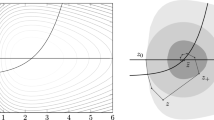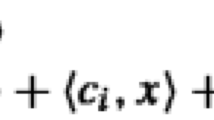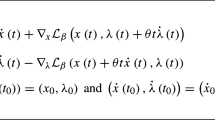Abstract
We consider the nonlinear optimal control problem with an integral functional in which the integrand function is the characteristic function of a given closed set in the phase space. The approximation method is applied to prove the necessary conditions of optimality in the form of the Pontryagin maximum principle without any prior assumptions on the behavior of the optimal trajectory. Similarly to the case of phase-constrained problems, we derive conditions of nondegeneracy and pointwise nontriviality of the maximum principle.
Similar content being viewed by others
References
L. S. Pontryagin, V. G. Boltyanskii, R. V. Gamkrelidze, and E. F. Mishchenko, Mathematical Theory of Optimal Processes [in Russian], Fizmatgiz, Moscow (1961).
Yu. N. Kiselev, Linear Theory of Time-Optimal Control with Perturbations [in Russian], Izd. MGU, Moscow (1986).
Yu. N. Kiselev, Optimal Control [in Russian], Izd. MGU, Moscow (1988).
L. W. Neustadt, “Synthesizing time-optimal control systems,” J. Math. Anal. Appl., 1, No. 3, 4, 484–493 (1960).
J. O. Eaton, “An iterative solution to time optimal control,” J. Math. Anal. Appl., 5, No. 2, 329–344 (1962).
Yu. N. Kiselev, “Fast converging algorithms for the linear time-optimal control problem,” Kibernetika, No. 6, 47–57 (1990).
S. N. Avakumov, Yu. N. Kiselev, and M. V. Orlov, “Methods of solving optimal control problems by the Pontryagin maximum principle,” Trudy MIAN im. V. A. Steklova, 211, 3–31 (1995).
Yu. N. Kiselev and M. V. Orlov, “Numerical algorithms for linear time-optimal control,” Zh. Vychisl. Matem. i Mat. Fiziki, No. 12, 1763–1771 (1991).
B. N. Pshenichnyi, “Numerical method for computing time-optimal control for linear systems,” Zh. Vychisl. Matem. i Mat. Fiziki, No. 1, 52–60 (1964).
T. Fujisawa and Y. Yasuda, “An iterative procedure for solving the time-optimal regulator problem,” J. SIAM Control, 5, No. 4, 501–512 (1967).
V. I. Blagodatskikh, An Introduction to Optimal Control [in Russian], Vysshaya Shkola, Moscow (2001).
R. P. Fedorenko, Approximate Methods for Optimal Control Problems [in Russian], Nauka, Moscow (1978).
N. S. Bakhvalov, N. P. Zhidkov, and G. M. Kobel’kov, Numerical Methods [in Russian], Nauka, Moscow (1987).
N. N. Kalitkin, Numerical Methods [in Russian], Nauka, Moscow (1978).
A. V. Pogorelov, Differential Geometry [in Russian], 7th ed., Nauka, Moscow (1979).
Yu. N. Kiselev, “Approximation of a smooth convex compactum by osculating ellipsoids,” in: Proc. 9th Int. Conf. on Automatic Control “Avtomatika-2001” [in Russian], Vol. 1, Izd. Odessa Nat. Tech. Univ., Odessa (2001), pp. 31–32.
Yu. N. Kiselev, “Projecting a point on a convex compactum,” in: Proc. 9th Int. Conf. on Automatic Control “Avtomatika-2001” [in Russian], Vol. 1, Izd. Odessa Nat. Tech. Univ., Odessa (2001), pp. 30–31.
N. V. Khabarov, “Quadratic-convergence algorithms to project a point on a smooth convex compactum,” in: Abstracts of papers VZMSh (2001), pp. 269–270.
N. V. Khabarov, “Quadratic-convergence algorithms for time-optimal control problem,” in: Abstracts of papers VVMSh (2001), pp. 164–165.
N. V. Khabarov, “Algorithms to solve the time-optimal control problem by projecting the terminal state onto the reachability set,” in: Proc. XXIVth Conf. of Young Scientists of the Faculty of Mechanics and Mathematics of the Lomonosov University [in Russian], Izd. MGU, Moscow (2002), pp. 182–184.
N. V. Khabarov, “Algorithm to solve the time-optimal control problem using osculating ellipsoids,” in: Proc. Voronezh Spring Mathematical School “Pontryagin Readings-XIII” [in Russian], Izd. Voronezh Univ., Voronezh (2002), pp. 156–157.
Yu. N. Kiselev and N. V. Khabarov, “Quadratic convergence of the projection scheme in the problem of capture of a point by a family of complex bodies,” Issledovano v Rossii: Electronic Journal, 170, 2068–2077 (2003) [http://zhurnal.ape.relarn.ru/articles/2003/170.pdf].
Yu. N. Kiselev and N. V. Khabarov, “Osculating ellipsoids in algorithms to solve the linear time-optimal control problem,” in: Proc. 10th Int. Conf. on Automatic Control “Avtomatika-2003” [in Russian], Vol. 1, Izd. Sevastopol’ Nat. Tech. Univ., Sevastopol’ (2003), pp. 49–50.
N. V. Khabarov, A Method to Solve the Linear Optimal Control Problem with a “Difference Norm” Terminal Functional Using Osculating Ellipsoids [in Russian], Moscow (2003). Manuscript deposited in VINITI 20.10.2003, No. 1832-V2003.
N. V. Khabarov, A Method to Solve the Linear Time-Optimal Control Problem Using Osculating Ellipsoids [in Russian], Moscow (2003). Manuscript deposited in VINITI 20.10.2003, No. 1834-V2003.
Additional information
__________
Translated from Nelineinaya Dinamika i Upravlenie, No. 4, pp. 241–256, 2004.
Rights and permissions
About this article
Cite this article
Kiselev, Y.N., Khabarov, N.V. Quadratic convergence algorithms for the problem of capture of a point by a family of convex bodies. Comput Math Model 19, 57–72 (2008). https://doi.org/10.1007/s10598-008-0006-7
Issue Date:
DOI: https://doi.org/10.1007/s10598-008-0006-7




